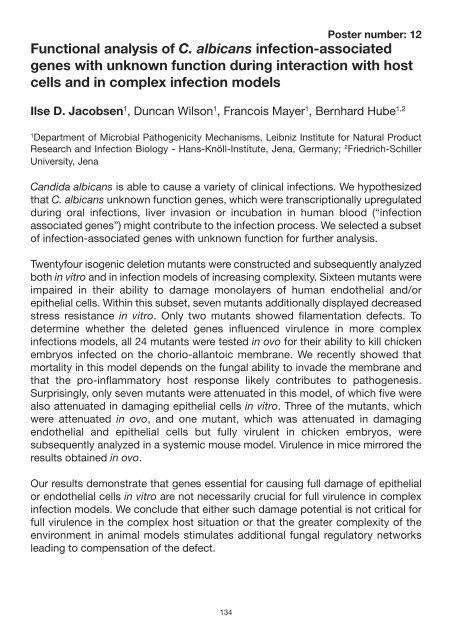Candida Infection Biology – fungal armoury, battlefields ... - FINSysB
Candida Infection Biology – fungal armoury, battlefields ... - FINSysB
Candida Infection Biology – fungal armoury, battlefields ... - FINSysB
Create successful ePaper yourself
Turn your PDF publications into a flip-book with our unique Google optimized e-Paper software.
Poster number: 12<br />
Functional analysis of C. albicans infection-associated<br />
genes with unknown function during interaction with host<br />
cells and in complex infection models<br />
Ilse D. Jacobsen 1 , Duncan Wilson 1 , Francois Mayer 1 , Bernhard Hube 1,2<br />
1 Department of Microbial Pathogenicity Mechanisms, Leibniz Institute for Natural Product<br />
Research and <strong>Infection</strong> <strong>Biology</strong> - Hans-Knöll-Institute, Jena, Germany; 2 Friedrich-Schiller<br />
University, Jena<br />
<strong>Candida</strong> albicans is able to cause a variety of clinical infections. We hypothesized<br />
that C. albicans unknown function genes, which were transcriptionally upregulated<br />
during oral infections, liver invasion or incubation in human blood (“infection<br />
associated genes”) might contribute to the infection process. We selected a subset<br />
of infection-associated genes with unknown function for further analysis.<br />
Twentyfour isogenic deletion mutants were constructed and subsequently analyzed<br />
both in vitro and in infection models of increasing complexity. Sixteen mutants were<br />
impaired in their ability to damage monolayers of human endothelial and/or<br />
epithelial cells. Within this subset, seven mutants additionally displayed decreased<br />
stress resistance in vitro. Only two mutants showed filamentation defects. To<br />
determine whether the deleted genes influenced virulence in more complex<br />
infections models, all 24 mutants were tested in ovo for their ability to kill chicken<br />
embryos infected on the chorio-allantoic membrane. We recently showed that<br />
mortality in this model depends on the <strong>fungal</strong> ability to invade the membrane and<br />
that the pro-inflammatory host response likely contributes to pathogenesis.<br />
Surprisingly, only seven mutants were attenuated in this model, of which five were<br />
also attenuated in damaging epithelial cells in vitro. Three of the mutants, which<br />
were attenuated in ovo, and one mutant, which was attenuated in damaging<br />
endothelial and epithelial cells but fully virulent in chicken embryos, were<br />
subsequently analyzed in a systemic mouse model. Virulence in mice mirrored the<br />
results obtained in ovo.<br />
Our results demonstrate that genes essential for causing full damage of epithelial<br />
or endothelial cells in vitro are not necessarily crucial for full virulence in complex<br />
infection models. We conclude that either such damage potential is not critical for<br />
full virulence in the complex host situation or that the greater complexity of the<br />
environment in animal models stimulates additional <strong>fungal</strong> regulatory networks<br />
leading to compensation of the defect.<br />
134


